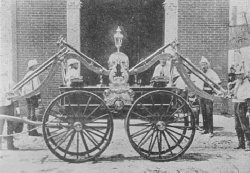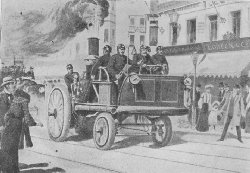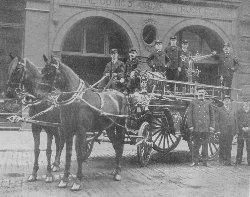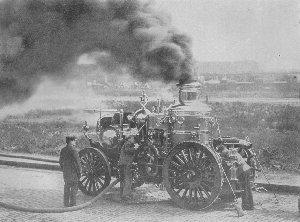The Germans and French say that we ought to have the best fire departments in the world, because we have more fires than any other country, and, consequently, more experience in fighting them. Our force is nearly four times that of Germany or France in proportion to the population, and three times that of England.
One difference between London and Chicago is that there the fire stations offer living accommodations to the wives and children of the married men. Glasgow boasts of an even finer fire house than London can show. Its headquarters fire station, opened in 1898, is a six-story building, with a granite and marble front. The walls of the rooms where the engines and trucks stand are of highly polished onyx and granite. The building contains a large sitting-room, billiard room, and gymnasium. The fire station cost $300,000, and is, probably, the finest in the world. There is no business in which the value of the stitch in time tells more than in fire fighting. The insignificant burning of a window curtain may, in two hours, become a blaze before which a thousand men and an equipment costing millions of dollars will stand helpless. Therefore the finest record of any department is likely to be found in the number of small fires put out before they become dangerous to property and life. The last printed report of the Chicago fire department, which may be taken as typical of that in this country shows that in 1901, out of a total of 5,135 fires, the loss, at 1,716 fires, was less than $10. At 1,334 fires, the loss was between $10 and $50; at 1,074 fires, the loss was between $100 and $1,000.
In London the signal from a street station sounds in the nearest firehouse. The objection to this is that that particular engine may be out, which might mean much before another engine could be notified. At headquarters, the moment an alarm is sent out which calls away an engine, a note is made of it upon a frame or chart, which shows at a glance the sign "out" opposite the engine's number. When the company returns to the house, the first thing the captain does is to report the return of his company to headquarters. When an alarm is received at the engine house all is orderly excitement. The chains fall down from in front of the horses, allowing them to run to their places in front of the engine or hose trucks, the men come sliding down the brass poles from the story above, and the collars are snapped around the horses' necks, and, by the time the signal stops, all is ready for a dash out of doors or a quiet return to quarters. The equipment that makes the departure of a fire engine from its house possible inside of ten seconds after the first clang of the alarm bell, with steam up and its regular crew, is the result of many inventions and persistent drill. As it is essential that no time be lost in getting up steam in the engine, steam is always maintained under a pressure of from five to twenty pounds in the engine boiler by means of a stationary boiler in the basement. This is connected with the engine by a pipe which is disconnected automatically when the horses start off. At the same instant the fireman lights the fire under the engine boiler with a handful of oil waste, and by the time it has gone two blocks, there is a blaze of hot coals and a head of steam to work with. Electricity drops the stall chains in front of the horses at the same time it begins to ring the alarm. The men, who sleep with one eye open, come down the poles faster than they could tumble down any staircase. The fire horses, two for light engines, and three when the machines weigh more than four tons—are trained as finely as the men. They are the pets of the house and of the neighborhood. Some of them learn in a week to run to their places at the signal; others require a month's training. The lessons are simple enough. A raw horse is made to feel the whip as he hears the signal bell. If be is an intelligent animal, the two so soon become synonymous that he starts for his place the instant the bell rings. Many horses seem to know quite as well as the men, when the alarm is one that means business. They really seem to count the strokes. It is highly probable that the days of the fire horse are numbered. Steam as a motive power for fire engines, although used in several American cities, and in many European ones, has never found favor in Chicago. The difficulty in getting up power quickly enough seems to be the trouble. Electricity, however, which is now used in Paris and Berlin, is pretty certain to displace the horse within the next few years. Its chief advantages are that it makes a quicker start possible than with horses, and that the same power which propels the machine through the streets can be used for pumping-apparatus when the fire is reached. Moreover, no fire is needed, thus doing away with lots of smoke and noise that add to the confusion inseparable from any fire alarm. Another fact in favor of electricity is that if, as so often happens, there is no fire worth talking. about, or one that can be put out, with an extinguisher, there is no loss of fuel and labor. At present, every engine is expected to arrive at the fire with its own fire blazing hot. The cleanliness and neatness of an engine house that requires no boiler, handles no coal or ashes and keeps no horses on its premises, may be imagined. Heretofore, it has been objected that if electrical apparatus gets out of order the men are helpless, and, formerly, electricity was not so commonly used as at present; this may have had some force. The modern equipment for fire fighting consists of engines for pumping water, hose for distributing it at the fire, various sizes and lengths being used, according to need, ladders for getting up into buildings, lifelines, and nets into which people jump, if they have to. Each hose-cart, also carries two chemical extinguishers, having a capacity of fifty gallons each. In the last five, years an average of forty fires a year has been put out with the aid of these extinguishers alone. The ladders are of various types, from small ones, to be carried by the firemen, to the extension ladders raised by a crank, which reach to a height of ninety feet, or to the sixth story of an ordinary building. One of the most interesting novelties shown at the Paris Fire Congress of 1900 was an eighty-five-feet extension ladder from Frankfort, Germany, built on the telescope plan, and raised by compressed air to its full height in 25 seconds. The scaling ladders used by firemen, to climb up the outside of a building where ordinary ladders fail, consist of long poles into which crosspieces, or rungs, are inserted, by which a man may climb. At the end of each pole is a long spike-projection, to be thrust through the window sash. With a supply of such ladders trained firemen can get to the top of a building in an incredibly short time. It is largely a matter-of-practice period. In addition to all this apparatus, there must also be mentioned the water tower, which raises a hose nozzle to the level of the upper stories, a searchlight, for use upon dark nights, and a gun, by which a rope may be sent up to the tops of buildings. In the fireboat Illinois, Chicago has the most powerful and effective fire fighter in the world. There is a boat in New York that approaches it in completeness and capacity to throw river water, yet nowhere has it an equal. The Illinois was built in the year 1888, and is the newest and most rnodern fire boat that floats. The Illinois is 118 feet in length, twenty-four feet in depth, and has a hold depth of twelve and a half feet. To construct and fit it out cost about $100,000. In viewing it from some distance an uninitiated observer might well take it for an engine of destruction instead of saving warfare, for its big brass bores at the bow and stern suggest the shell-throwing howitzers we read about. The Illinois is throughout protected from fire, its exterior and interior being metal plated. The hull of the boat has two novel features suggested by its liability, in the winter season, to meet ice obstructions. The prow does not extend down into the water the usual depth, while the bottom line of the vessel slopes upward, so that when the boat encounters ice in hurrying to the scene of a conflagration, it glides upon it, and its own weight carries down the ice. All the machinery of the Illinois is below the water line. There are six double cylinder engines, three of which supply the power of operating the great double pumps which rush the water through the stand pipes and hose lines. The other three engines run the electric dynamos and supply motive power to the boat. So powerful are the pumps of this boat that eleven streams of water may be thrown at one time, or a double stream may be shot up to a distance of one hundred and ninety feet. WHAT A POUND OF COAL CAN DO |



